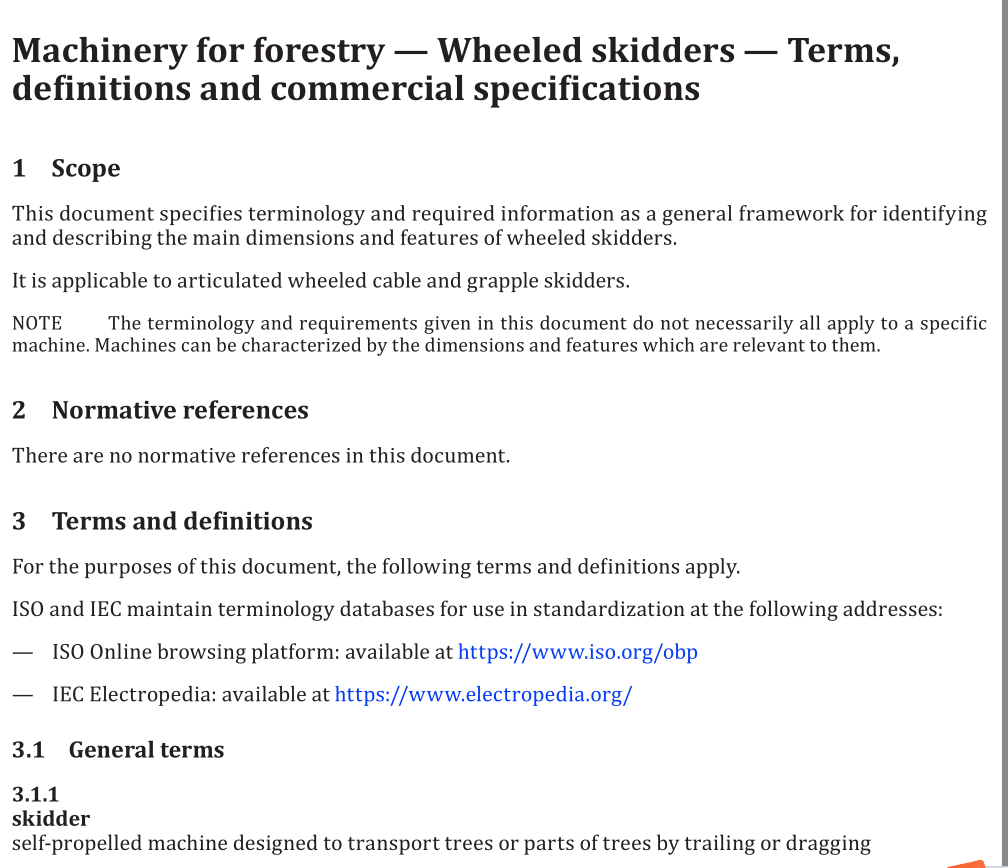ISO 13861 pdf download

ISO 13861 pdf download Machinery for forestry — Wheeled skidders — Terms, definitions and commercial specifications
1 Scope
This document specifies terminology and required information as a general framework for identifyingand describing the main dimensions and features of wheeled skidders.
lt is applicable to articulated wheeled cable and grapple skidders.
NOTE The terminology and requirements given in this document do not necessarily all apply to a specificmachine.Machines can be characterized by the dimensions and features which are relevant to them.
2Normative references
There are no normative references in this document.
3Terms and definitions
For the purposes of this document, the following terms and definitions apply.
ISO and IEC maintain terminology databases for use in standardization at the following addresses:-ISO online browsing platform: available at https://www.iso.org/obp
一IEC Electropedia: available at https://www.electropedia.org/3.1General terms
3.1.1
skidder
self-propelled machine designed to transport trees or parts of trees by trailing or dragging[SOURCE: ISO 6814:2009,2.3.1.15]
3.1.2
ground reference planeGRP
hard, flat, horizontal surface on which the machine is placed for measurements
3.2Terms related to masses
3.2.1
normal operating mass
total mass of the machine as specified, fully serviced, with full fluid levels and a 75 kg operator3.2.2
maximum operating mass
total mass ofthe machine as specified, fully serviced, with full fluid levels anda 75 kg operator, includingall machine options with the largest tyre or hydro-inflation combination and the manufacturer’smaximum specified load
3.3.7
overall heighth1
vertical distance between the ground reference plane(3.1.2) and a horizontal plane passing through thehighest point of the machine
Note 1 to entry: See Figure A.1.3.3.8
blade heighth2
vertical distance from the lower edge, resting on the ground reference plane (3.1.2), to the top of theblade, decking lugs excluded
Note 1 to entry: See Figure A.1.3.3.9
maximum blade lift of lower edgeh3
maximum vertical height to which the lower edge of the blade can be raised from the ground referenceplane (3.1.2)
Note 1 to entry: See Figure A.1.3.3.10
lowest blade positionh4
vertical distance from the ground reference plane (3.1.2) to the blade’s lower edge with blade at itslowest position
Note 1 to entry: See Figure A.1.3.3.11
ground clearancehe
vertical distance from the ground reference plane(3.1.2) to the lowest point of the machine centreportion, i.e. 25 % of the tread (3.3.19) to either side of the longitudinal centreline
Note 1 to entry: See Figure A.2.
3.3.12
ground clearance at articulation jointh6
vertical distance from the ground reference plane(3.1.2) to the lowest point at the articulation jointNote 1 to entry: See Figure A.1.
3.3.13
loaded tire radiusr1
vertical distance from the ground reference plane (3.1.2) to the horizontal centre of the axle with themachine at normal operating mass(3.2.1)
Note 1 to entry: See Figure A.1.
3.3.14
main fairlead roller heighth-
vertical distance from the horizontal centre of the main fairlead roller to the horizontal centre of the axle
Note 1 to entry: See Figure A.1.
3.3.15
winch heighthg
vertical distance from the horizontal centre of the winch drum to the horizontal centre of the axleNote 1 to entry: See Figure A.1.
3.3.16
rear axle to main fairlead rollerl,
horizontal distance from the vertical centre of the rear axle to the vertical centre of the main fairleadroller
Note 1 to entry: See Figure A.1.3.3.17
main fairlead roller diameterdi
diameter of main fairlead roller at its mid-length positionNote 1 to entry: See Figure A.1.
3.3.18
overall widthw1
horizontal distance between two vertical planes parallel to the longitudinal axis of the machine andpassing through the farthest points on the two sides of this axis
Note 1 to entry: See Figure A.2.
3.3.19
treadw2
horizontal distance between two parallel vertical planes passing through the centreline of the tires onan axle
Note 1 to entry: See Figure A.2.3.3.20
frame oscillationa1
angle that one frame will rotate from a horizontal datum, in both directions, without rotating the otherframe, measured in degrees
Note 1 to entry: See Figure A.2.3.3.21
axle oscillationa2
angle that one axle will rotate from a horizontal datum, in both directions,without rotating eitherframe, measured in degrees
Note 1 to entry: See Figure A.2.









